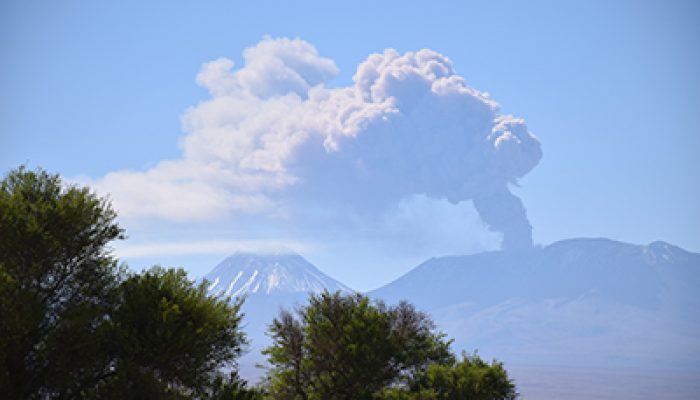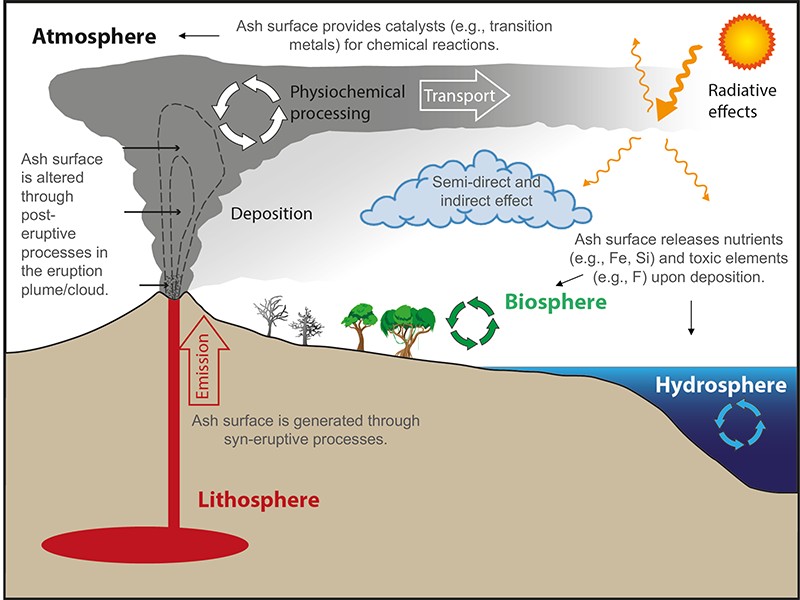
Volcanic ash is a spectacular companion of volcanic activity that carries valuable information about the subsurface processes. It also poses a range of severe hazards to public health, infrastructure, aviation, and agriculture, and it plays a significant role in biogeochemical cycles.
Scientists can examine ash particles from volcanic eruptions for clues to the history of their journey from the lithosphere (Earth’s crust and upper mantle) to atmosphere, hydrosphere, and biosphere (Figure 1). These tephra particles are less than 2 millimeters in diameter, and they record most of the history on or near their surfaces. Understanding the physicochemical properties of the ash particle surfaces is essential to deciphering the underlying volcanic and atmospheric processes and to predicting the widespread effects and hazards posed by these small particles. This has been extensively investigated recently but several fundamental questions remain open.

Figure 1: Particle surface properties strongly affect the life cycle and effects of volcanic ash particles within the Earth system (Credit: G. Hoshyaripour).
For example, ash surface generation and alteration through processes occurring during eruption (e.g., fragmentation and recycling) and after eruption (e.g., aggregation, cloud chemistry, and microphysics) are not yet quantitatively well understood and thus are not fully implemented in the models. Therefore, gaps remain in our understanding of the volcanic and atmospheric life cycle of the ash and how this life cycle is linked to the ash’s surface properties and environmental effects. This limitation hinders the reliable estimation of far-field airborne ash concentrations, a central factor in assessing the ash hazard for aviation.
Addressing the challenges in volcanic ash surface characterization requires close collaboration of experts in laboratory experiments, in situ measurements, space-based observations, and numerical modeling to co-develop reliable assessment tools for both fundamental research and operational purposes. These actions should involve specialists from geochemistry, geology, volcanology, and atmospheric sciences to combine the advanced experimental and observational data on rate parameters of physicochemical processes and ash surface characteristics with state-of-the-art atmospheric models that incorporate aerosol chemistry, microphysics, and interactions among ash particles, clouds, and solar radiation in local to global scales.
As the first step in this direction, a joint European Geophysical Union (EGU) and American Geophysical Union (AGU) session on volcanic ash is organized in the upcoming general assembly and fall meeting entitled: Volcanic Ash—Generation, Transport, Impacts, and Applications. The next steps should include 1) initiation a collaborative network with two working groups on the physical and geochemical life cycles of volcanic ash; 2) development an integrated modeling, observational, and experimental data compilation on mid- to large-intensity eruptions to assist with benchmark modeling.
These actions should be linked to the existing activities within the International Association of Volcanology and Chemistry of the Earth’s Interior, EGU, and AGU.
The workshop was supported by the excellence cluster CliSAP (DFG EXE 177).
This blog post has been originally prepared as a meeting report referring to a workshop in Hamburg, Germany, sponsored by the excellence cluster CliSAP (DFG EXE 177).
This blog has been prepared by Ali Hoshyaripour (@Hoshyaripour – email: ali.hoshyaripour@kit.edu), Institute of Meteorology and Climate Research, Karlsruhe Institute of Technology, Germany and edited by Dasaraden Mauree (@D_Mauree).
